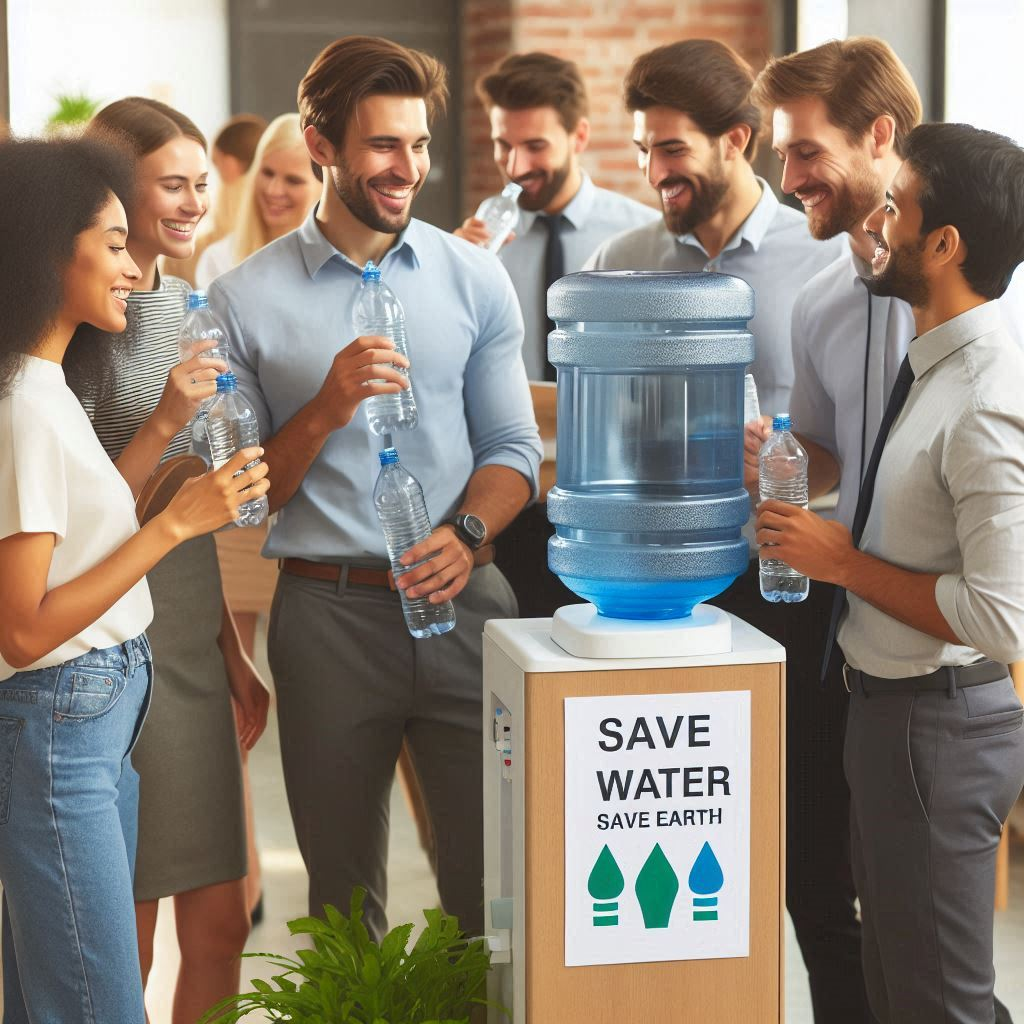Saving water is crucial not only at home but also in professional settings like offices, homes, schools, and different workplaces. With increasing concerns about water scarcity and environmental sustainability, it’s essential to implement effective water-saving strategies at the workplace.
In this article, I will tell you ten practical ideas to conserve water in offices. These strategies not only help reduce water bills but also contribute to a greener, more sustainable office environment.
Why Saving Water in Offices Matters
The Importance of Water Conservation
Water is a finite resource, and its scarcity affects millions globally. Offices, being high-traffic areas, can have a significant impact on water usage. By adopting water-saving measures, businesses can reduce their ecological footprint, lower operational costs, and set an example for others in their community.
Current Water Usage Statistics
According to the U.S. Environmental Protection Agency (EPA), the average office uses approximately 10,000 gallons of water per year per employee. This includes water for restrooms, kitchens, and landscaping. Reducing this usage can lead to substantial savings and environmental benefits.
1. Install Low-Flow Fixtures
Benefits of Low-Flow Fixtures
Low-flow faucets, toilets, and showerheads can significantly cut down water consumption. For instance, low-flow toilets use about 1.6 gallons per flush compared to older models that use 3.5 gallons. Similarly, low-flow faucets and showerheads can reduce water use by up to 50%.
Implementation Tips
- Replace existing fixtures with low-flow models.
- Regularly check for leaks and ensure all fixtures are functioning properly.
2. Implement Water-Efficient Landscaping
Water-Efficient Landscaping Techniques
If your office has landscaping, consider using drought-resistant plants that require less water. Installing drip irrigation systems can also target water directly to the plant roots, reducing waste.
Office Landscaping
I found that businesses implementing water-efficient landscaping reduced water use by 30-50%. This simple change can lead to significant savings.
3. Promote Responsible Water Use Habits
Encouraging Responsible Use
Educate employees on the importance of saving water and encourage them to adopt water-saving habits. This can include turning off taps while washing hands, reporting leaks, and using water wisely in the kitchen.
Training and Awareness
Regular training sessions and informational posters around the office can remind employees of their role in water conservation. Create a water conservation policy to formalize these practices.
4. Use Water-Efficient Appliances
Choosing the Right Appliances
When purchasing new office appliances, look for models with water-saving features. Dishwashers and coffee makers with efficient water use can contribute to overall savings.
Product Recommendations
- Dishwashers with Energy Star ratings.
- Coffee machines with automatic shut-off features.
5. Fix Leaks Promptly
The Impact of Leaks
Even small leaks can waste large amounts of water. A dripping faucet can waste up to 3,000 gallons per year, and a leaking toilet can waste up to 200 gallons per day.
Leak Detection and Repair
Regular maintenance checks can help identify and fix leaks early. Encourage employees to report any issues they notice, and have a plumber on call for prompt repairs.
6. Optimize Irrigation Systems
Efficient Irrigation Practices
For offices with landscaping, optimizing irrigation systems can make a big difference. Use smart irrigation controllers that adjust watering schedules based on weather conditions and soil moisture.
Example: Smart Irrigation
Smart irrigation systems have been shown to reduce water use by up to 50% compared to traditional systems. These systems ensure that plants receive the right amount of water without over-irrigation.
7. Install Water Meters
Benefits of Water Metering
Installing water meters allows you to monitor water usage in real time. This helps identify patterns and areas where water can be saved.
Usage Monitoring
Regularly review water meter data to track usage and detect any unusual spikes. This information can guide further conservation efforts and adjustments.
8. Promote Efficient Hand Washing
Hand Washing Tips
Encourage employees to wash their hands efficiently by using water-saving techniques. For example, turning off the tap while lathering soap and using hand sanitizers where appropriate can reduce water use.
Awareness Campaigns
Place signs near sinks with reminders on efficient hand washing practices. Share tips in company newsletters to reinforce these habits.
9. Reduce Water Use in the Kitchen
Kitchen Water Conservation
In office kitchens, implement practices to minimize water waste. This includes using dishwashers only when full, avoiding running water while rinsing dishes, and using efficient water-saving taps.
Kitchen Efficiency
In which office I work I found that offices could reduce kitchen water use by up to 30% with proper practices and appliance upgrades.
10. Implement a Water Recycling Program
Water Recycling Benefits
Recycling water within the office can reduce overall consumption. This might include systems for capturing and reusing rainwater for landscaping or installing greywater systems for non-potable uses.
Example: Rainwater Harvesting
Installing rain barrels to collect rainwater can be used for watering office plants and landscaping. This not only conserves municipal water but also reduces utility costs.
11. Educate and Involve Employees
Engaging Employees
Creating a culture of water conservation involves educating and involving employees. Hold workshops on water-saving techniques and involve staff in water conservation initiatives.
Recognition Programs
Recognize and reward teams or individuals who contribute significantly to water savings. This can motivate others to participate and reinforce the importance of conservation.
Personal Experience: A Simple Transformation
On a personal note, I recently tried a natural remedy to address some facial concerns. I used a turmeric and milk paste, which I applied to my face for a year. The results were impressive, showcasing how simple changes can lead to noticeable improvements. This experience underscores how small, deliberate actions—whether in personal care or office water use—can yield significant results.
Key Points to Save Water at Home

-
Fix Leaks Promptly
- Repair leaks in faucets, toilets, and pipes immediately.
- A dripping faucet can waste up to 3,000 gallons per year; a leaking toilet can waste up to 200 gallons per day.
-
Install Water-Efficient Fixtures
- Use low-flow faucets, showerheads, and high-efficiency toilets.
- Low-flow fixtures can reduce water use significantly without sacrificing performance.
-
Use Appliances Wisely
- Run dishwashers and washing machines with full loads only.
- Choose appliances with the EPA’s WaterSense label for better water efficiency.
-
Take Shorter Showers
- Limit shower time to under 5 minutes.
- Install a water-saving showerhead to reduce water use.
-
Turn Off the Tap
- Turn off the faucet while brushing teeth or washing hands.
- Avoid running water unnecessarily.
-
Use a Broom Instead of a Hose
- Clean driveways, sidewalks, and steps with a broom instead of using a hose.
-
Water Plants Efficiently
- Water plants early in the morning or late in the evening.
- Use a drip irrigation system or soaker hoses to deliver water directly to plant roots.
-
Collect Rainwater
- Install rain barrels to capture rainwater from gutters.
- Use collected rainwater for gardening and non-potable uses.
-
Use Mulch in Gardens
- Apply mulch around plants and garden beds to retain soil moisture and reduce evaporation.
-
Adjust Your Irrigation System
- Install a smart irrigation system that adjusts based on weather conditions and soil moisture.
- Regularly check and maintain your irrigation system to ensure efficiency.
-
Use the Right Amount of Detergents
- Follow detergent instructions to avoid excess use.
- Use the appropriate amount of detergent to prevent excessive rinsing.
-
Educate Your Family
- Teach family members about the importance of water conservation.
- Display reminders around the house to reinforce water-saving practices.
Conclusion
Implementing these water-saving strategies in your office not only contributes to environmental sustainability but also reduces operational costs. From installing low-flow fixtures and efficient appliances to educating employees and optimizing irrigation, every small step counts. By taking these actions, your office can become a model of water conservation and inspire others to follow suit.
Saving water is a collective effort, and every person in the office has a role to play. Embracing these practices will lead to a more sustainable and responsible workplace, benefiting both the environment and your organization’s bottom line.

